Stretched along the most northerly coast of Scotland is the epic North Coast 500 road trip. This “Route 66 of Scotland” takes you through some of the most rugged, beautiful and overall bewitching scenery in the world. From stretching beaches to towering mountains, this road trip literally has it all.
One of the many highlights of the NC500 is the history available at every twist and turn. Explore this incredible history with this guide to the main North Coast 500 castles.
Get planning your ultimate Scotland Road Trip with our 7-day North Coast 500 itinerary
No time to read now? No problem, save a pin to your Pinterest board for later!
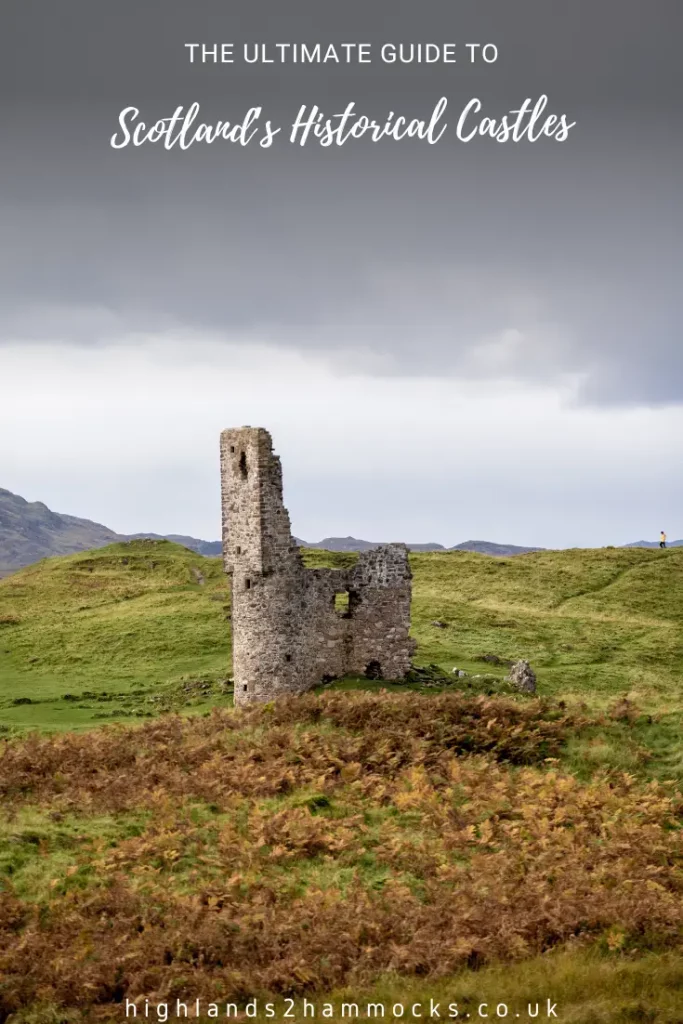
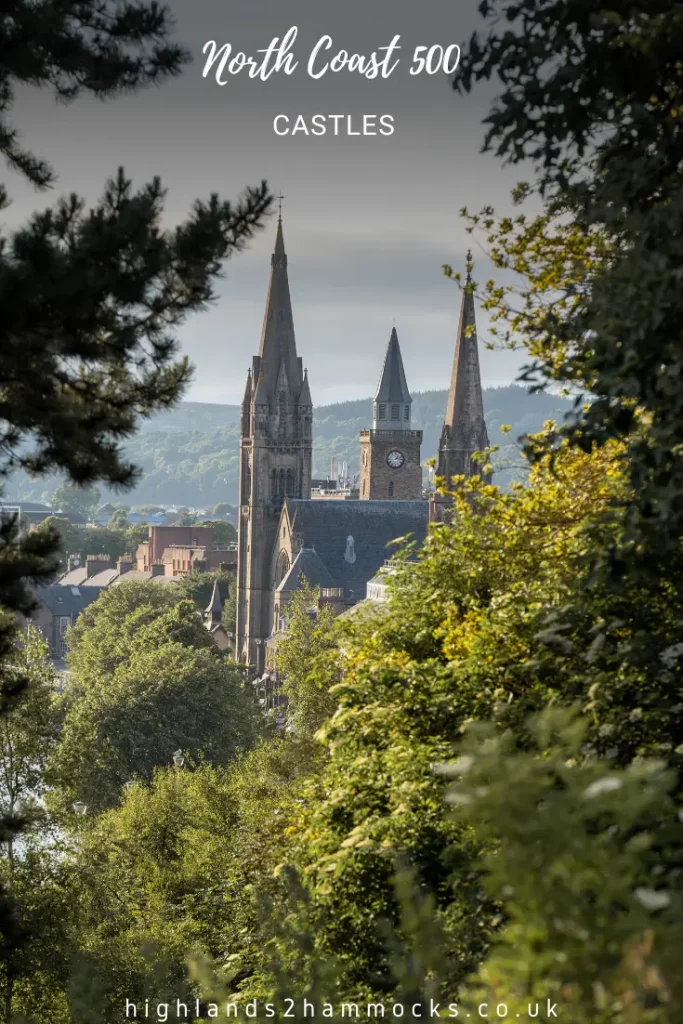
The Best Castles on the North Coast 500
In this guide, we will discuss all of Scotland’s most magical castles, including where they are and what their history is. Below is a list of all of the NC500 castles that will be discussed in greater detail later in the article.
Table of Contents
Planning Your Trip
We use the below booking platforms to plan our trips. We hope you find them useful too!
Where to Stay on the North Coast 500
There is a wide range of accommodations around the NC500 route, so you will not be short on options. Depending on how long you are spending in each area will depend on how long you spend in that location. It is worth bearing in mind that some accommodations will require you to stay a minimum number of nights so it is worth researching this when you are planning your North Coast 500 itinerary.
Our new book North Coast 500 Where to Eat and Stay shares the best places to eat and stay around the NC500 and includes whether places are dog friendly, accessible, have wifi and EVC and whether they cater to dietary requirements. Paired with our Destination NC500 guidebook you will have the perfect combo to start planning your roadtrip of a lifetime.
The remoteness in the highlands of Scotland will leave you with little choice of accommodation in each location along the NC500, however, there are still enough options to choose from to ensure a comfortable trip. These are mostly in the shape of B&Bs, Airbnbs, converted cottages and other quirky accommodations.
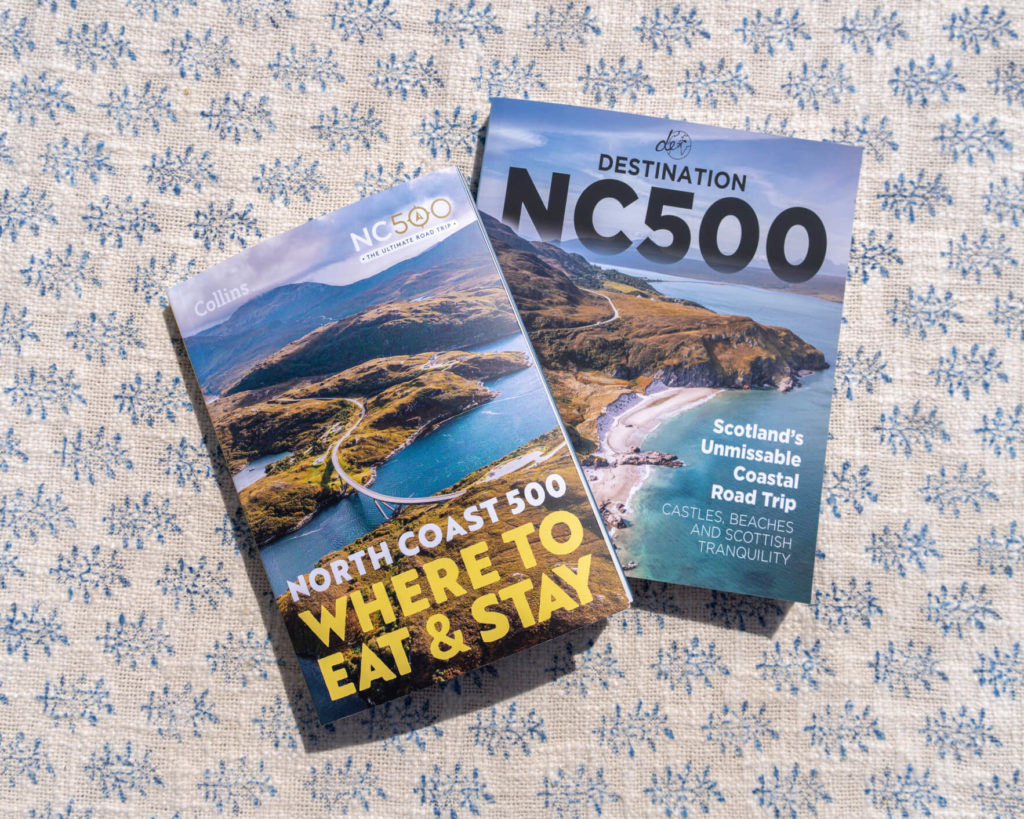
NC500 Motorhome and Campervan Scheme
The NC500 Motorhome Scheme, officially known as the Highland Campervan and Motorhome Scheme, was launched by the Highland Council on July 1, 2024. This innovative initiative is designed to address the growing number of motorhomes and campervans traveling along the popular North Coast 500 (NC500) route, ensuring that their impact on the local environment and communities is managed sustainably.
The scheme offers a voluntary seven-day pass costing £40, inclusive of VAT. This pass grants motorhome and campervan users access to 12 designated overnight parking locations along the NC500 route, including scenic spots like Torvean Car Park in Inverness, Nairn Harbour, Dunnet Head Car Park, and Ullapool Latheron Car Park.
These parking spots are available on a first-come, first-served basis from 10 PM to 8 AM, with a 72-hour no-return policy at each location. This ensures that the facilities are used responsibly and that a larger number of travellers can benefit from them.
Overall, the NC500 Motorhome Scheme provides a structured and sustainable approach to motorhome travel in one of Scotland’s most scenic and popular areas. We think this is a great idea and encourage everyone to take advantage of it if you are looking to explore this road trip soon.
Read all about this new scheme in our complete guide to the NC500 Motorhome Scheme here.
For more information or to purchase a membership, travellers can visit the Highland Council’s official website.
In 2018 we headed north, exploring the remote and spectacular highlands of our home country. We absolutely fell in love with the scenery along this route, learning the history of this fascinating place. The incredible history of the NC500 will take you on a walk through time as you explore the eight ancient castles along the route. Ranging from abandoned ruins to reconstructed masterpieces, these ruins will give you incredible insight into the lives of the residents’ hundreds of years before.
We quickly discovered that the entry fees for the castles are closely related to the condition of the structure. The ruined castles on NC500 are entirely free to visit and explore, meanwhile, the reconstructed castles charge a hefty entry fee. Being budget backpackers, we mostly preferred free exhibitions.
Although this was mostly due to the reduced cost of the trip, it was also due to the lack of a complete picture of the castle. In the same way, as a book gives a clearer picture than a movie, the ruined castles give more opportunity to use your imagination than the reconstructed ones. With the information boards sitting beside the castles, you can really let your imagination run wild.

Inverness Castle
Entrance Fee – £5 Adult / £3 Child
The first of the North Coast 500 castles is the famous Inverness castle, which sits high above the city, overlooking River Ness. Although the original site dates back to the 11th-century, the structure visible today was built in 1836. This castle isn’t open to the public at the moment, unfortunately, as it houses the Inverness Justice Centre.
However, with increasing public pressure, there is a chance it may open in the near future. In April 2017, the northern tower was opened as a viewpoint to the public and provides an incredible view over the beautiful city. We stood by River Ness and admired the stunning red sandstone architecture as we enjoyed a picnic.
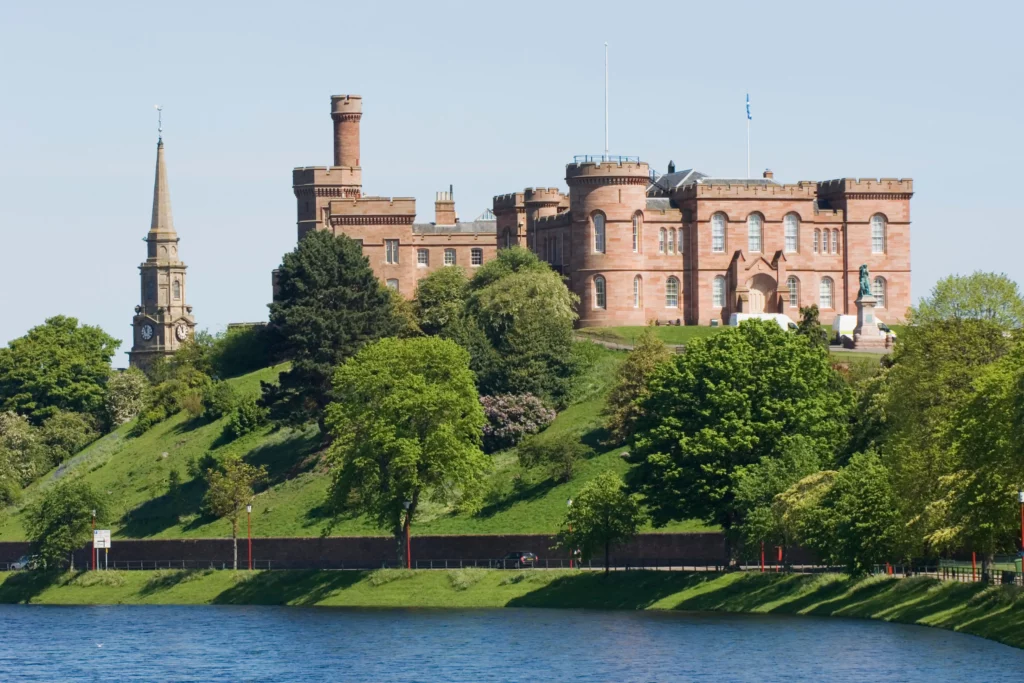
Dunrobin Castle
Entrance Fee – £12 / £7.50
Home to Clan Dunrobin, the Dunrobin Castle on the NC500 dates back to the Middle Ages. The majority of the current structure has sat here since built between 1835 and 1850. This castle lies north of Dornoch, on the east coast and is one of the largest castles in the northern highlands.
It is £12 entry, which we decided not to pay. Instead, we enjoyed the castle from the exterior. Go for a walk around the grounds and admire the outside of the building instead, as well as the quiet beach at the bottom of the hill.
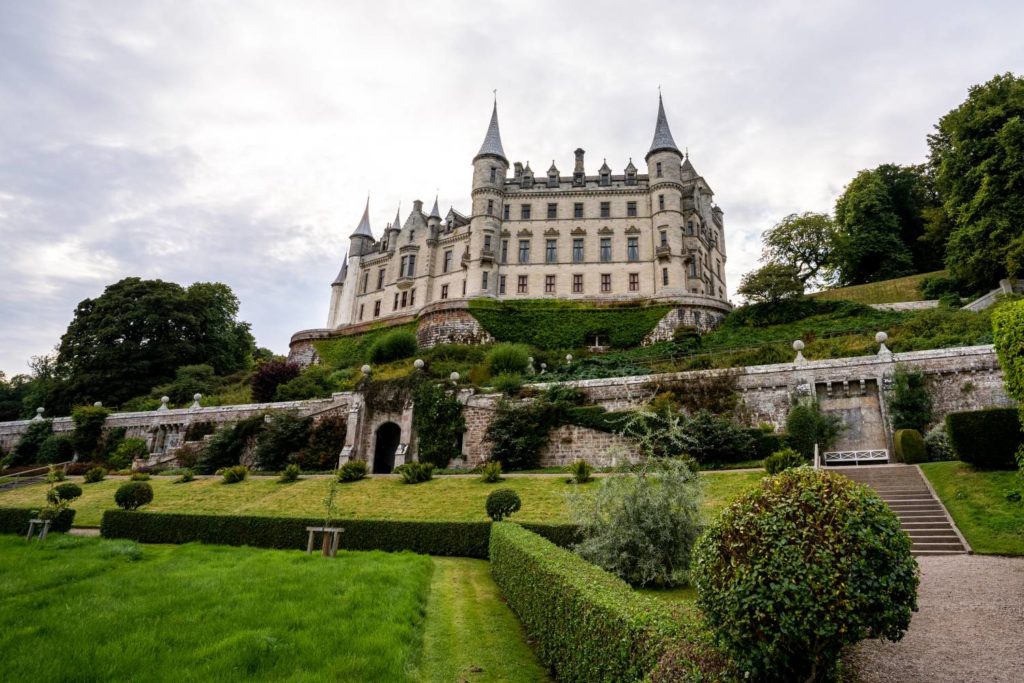
Castle Ardvreck (ruin)
Entrance Fee – FREE
One NC500 must see sight is the ancient Castle Ardvreck. Surrounded by the still waters of Loch Assynt, the ancient ruins of Castle Ardvreck are a sure sight to behold. Thought to date back to 1590, this castle was constructed by the Clan Macleod. This was then the stronghold for Clan Macleod until 1672, when it was captured by Clan Mackenzie. It was then inhabited until 1737, when a mysterious fire destroyed it beyond repair.
As you drive along the winding A837, you will see these ruins sitting proudly above the glistening waters.

Castle of Old Wick (ruin)
Entrance Fee – FREE
This was one of our favourite castle stops, believed to have been built in the 1100’s. This castle dates back to the days when the Norwegian Earldom of Orkney included Caithness. There is even evidence of occupation of this land dating back before the structure you see today was built.
Sitting on a thin stretch of land jutting out to sea, with cliff drops on either side, this castle is one of the more dramatic ones you will find on the route. The structure you find here once stood 4 stories tall, along with additional buildings housing workshops and other quarters.
Drive along a bumpy road before you reach Wick and you will find the ruins of Old Wick Castle. Despite the castle part of the castle collapsing, it remains an impressive sight against the skyline. There are information signs on the walk up to the castle which you can only imagine how they lived all those years ago.
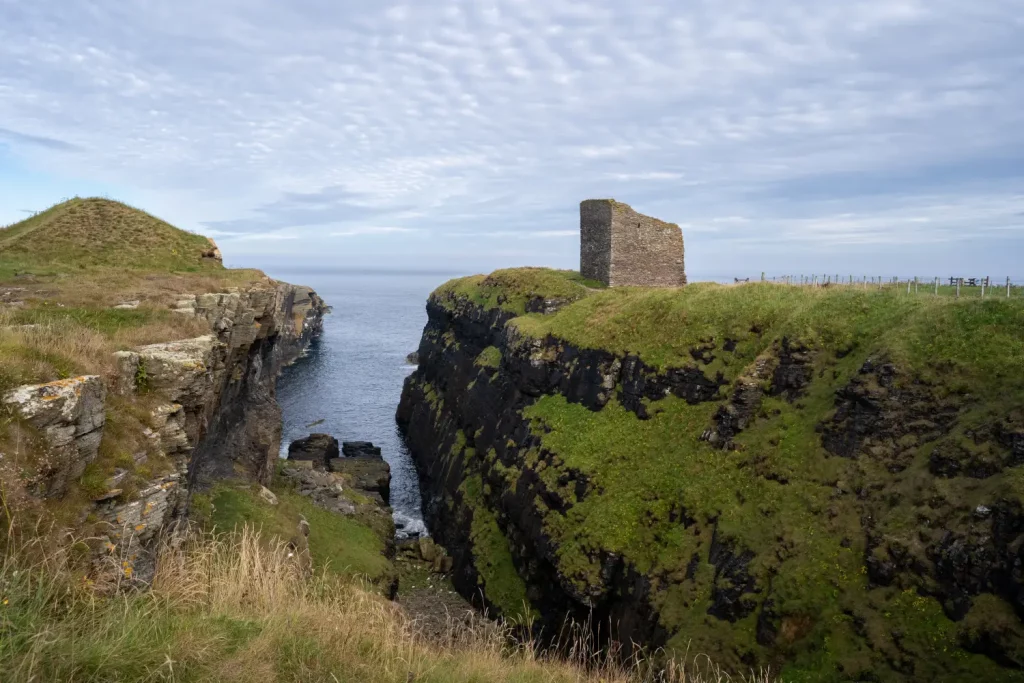
Castle Sinclair Girnigoe (ruin)
Entrance Fee – DONATION
The largest castle ruins on the Nc500 are the cliffside wonders of Castle Sinclair Girnigoe. The 15th century Castle Girnigoe and 17th century Castle Sinclair are believed to be one of the earliest seats of Clan Sinclair. Located around 3 miles north of Wick, these ruins are the most spectacular ruins you will find on the road trip.
Perched on the side of the cliff, these castles hold a fascinating historical tale. The structure was constructed between 1476 and 1606, with adaptions made to them spanning some 100 years. Throughout this time, these castles remained occupied by either Sinclair or Campbell, with ownership passing between the two. Occupation of this castle came to an end in 1680, when a siege to Castle Sinclair and Girnigoe saw it damaged so badly, it was never inhabited again.
This castle site is free entry, although there is a donation box on the gate. Reconstruction of the ruins aims to make Castle Sinclair the first castle on the North Coast 500 to be wheelchair accessible. By donating whatever you can to this cause, we can ensure everyone will have the opportunity to enjoy the beauty of Scotland.
Read our full guide to Castle Sinclair Girnigoe to plan your trip to the fullest.
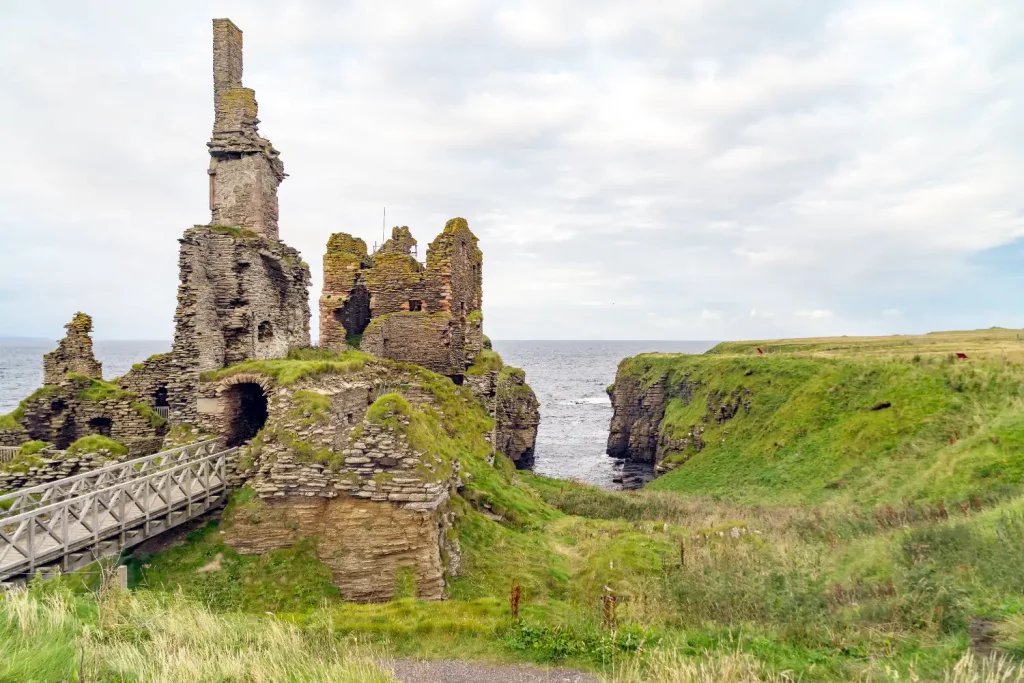
Castle Leod
Entrance Fee – £10 Adult/ £5 Child
The fully restored Castle Leod has a fascinating story of how it came to be. The earliest structures on this site are believed to date back to the 12th century, with additions being made to it constantly between then and the structure you see today. This ancient structure has been home to both Clan Macleod and Clan Mackenzie over the last 500 years.
This castle has remained inhabited throughout the vast majority of its life, apart from a short period of time at the end of the 18th century when it fell into disrepair. The castle was repaired during the 19th century and has been improved since then to the structure you see today. It remains home to the Earl of Cromotrie and is open to the public on a certain number of days. You can browse these days and the cost of a trip here.
This castle will be a familiar sight to all of the Outlander fans out there, being widely thought of as the main inspiration for Castle Leoch. However, during filming location consideration, it was instead decided to use Doune Castle for the home of Clan Mackenzie.
Castle of Mey
Entrance Fee (Castle, Garden and Grounds) – £12 Adults/ £6.50 Child
Entrance Fee – (Garden and Grounds) – £6.50 Adult / £3 Child
The reconstructed structure of the Castle of Mey sits just west of John O’Groats. The structure you see today was built between 1566 and 1572, with additional structures being added later in the 17th and 18th centuries. The name of the castle was also changed during this time to Barrogill Castle.
This castle is particularly fascinating as it has remained inhabited since its construction 450 years ago. It is now used as a visitors centre, with visitors topping 27,000 in its first year of opening in 2007. It is open between the 1st May and 30th September 7 days a week, apart from 10 days in July/August time when it is used as accommodation.
This castle has also been featured in of works of fiction, such as the novel “Spy Castle” and the Netflix show “The Crown”.
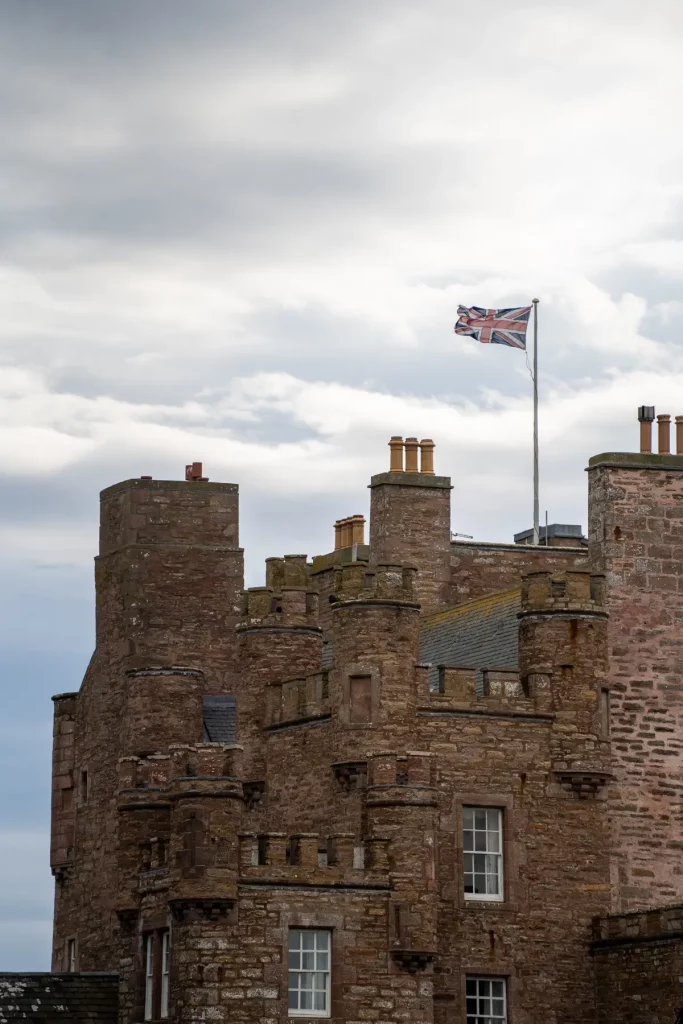
Castle Varrich (ruin)
Entrance Fee – FREE
One of the oldest castles on the NC500, Castle Varrich sits high above the local village of Tongue. This ancient castle is shrowded by mystery, with the exact dates of origin and construction mostly unknown. It is thought to have been the ancient seat of the chief of Clan Mackay, over one thousand years old.
Consisting of two floors plus an attic, it is far from the largest castle on the North Coast 500. However the condition of the remains are quite astounding given the 1000 years of aging. You can reach the ruins of Castle Varrich by a relatively easy, one hour walk from the town of Tongue.
Follow the signposts and you can’t miss it. As you enter Tongue, you will be able to see the ancient ruins sitting above the Kyle of Tongue. In 2017, a spiral staircase and viewing platform were installed to give visitors access to the stunning views over the Kyle of Tongue and surrounding mountains.
Before You Leave on the North Coast 500
Before you head off on your trip around the NC500, there are certain things you will need to get organised to ensure a smooth trip. These include how to get around the route, including being aware of single track roads, etc., what to pack for Scotland, where to stay along the route and what travel insurance to book.
How Do I Get Around?
Given the remote location of the NC500 and the majority of the sights along the route, the best way to get around this road trip is by driving. There are of course other methods that are still popular, such as cycling and hiking, however, if you have a short amount of time on the route, neither of these are very suitable.
As for public transport, the use around the NC500 is understandably difficult due to how remote each location is, however, with the increasing problem of congestion along the route, this is a good option to research if you have time. If it is something that interests you, you can read a public formed itinerary of how to get around the NC500 by public transport over here.
If you are looking to rent a cosy, reliable and luxurious campervan for your trip along the NC500, we highly recommend hiring through Bunk Campers. We toured with these guys around the up-and-coming Heart 200 road trip in Scotland’s central highlands and could not believe the comfort and customer service we experienced with their vans.
Browse the full range of vehicles on offer at Bunk Campers over here.
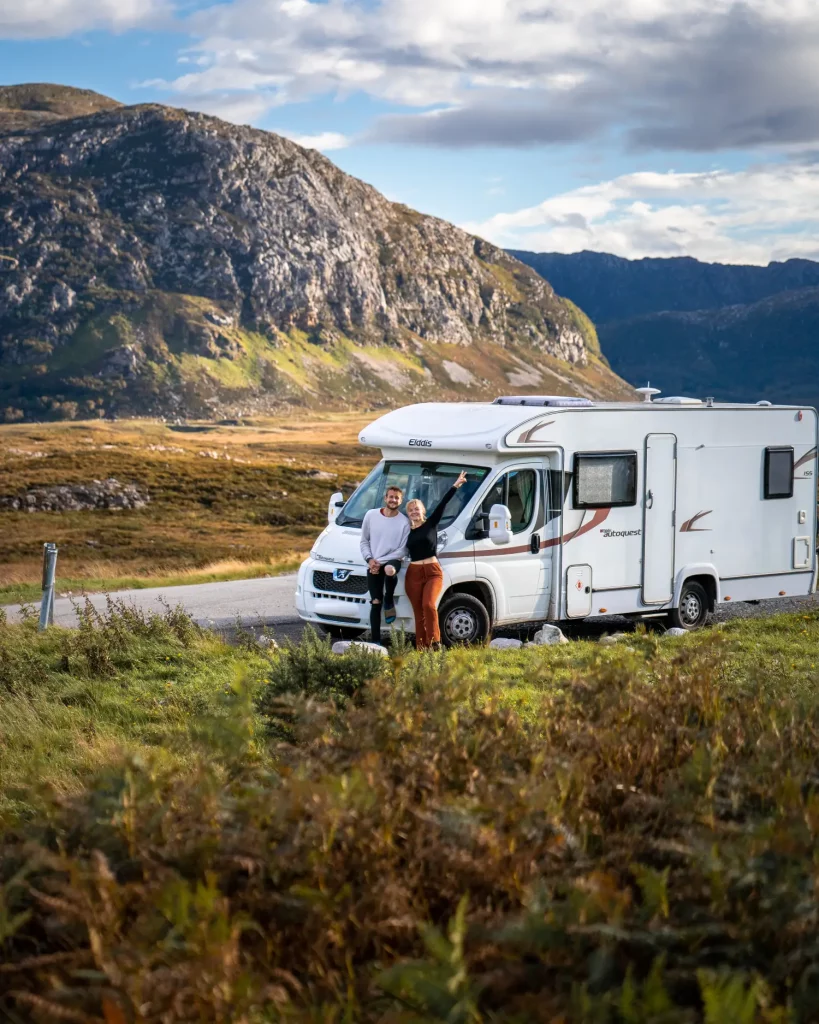
Where to Stay on the NC500
There is a wide range of accommodations around the NC500 route, so you will not be short on options. Depending on how long you are spending in each area will depend on how long you spend in that location. It is worth bearing in mind that some accommodations will require you to stay a minimum number of nights so it is worth researching this when you are planning your North Coast 500 itinerary.
Our new book North Coast 500 Where to Eat and Stay shares the best places to eat and stay around the NC500 and includes whether places are dog friendly, accessible, have wifi and EVC ad whether they cater to dietry requirements.
The remoteness in the highlands of Scotland will leave you with little choice of accommodation in each location along the NC500, however, there are still enough options to choose from to ensure a comfortable trip. These are mostly in the shape of B&Bs, Airbnbs, converted cottages and other quirky accommodations.
Depending on how adventurous you are, there may be more accommodation choices than just the above, often with an even better view. Caravan and camping sites are abundant along the NC500, drawing camping enthusiasts from all over the world. For some of the most spectacular bedside scenery along the North Coast 500, we recommend packing a tent and getting in touch with nature for the week.
As we travelled along the North Coast 500, camped in our trusty Vango tent on a mixture of campsites and wild sites. Wild camping is a fantastic way to enjoy the beauty of the highlands, however, it must be done respectfully. Read our full guide to Wild Camping if you wish to give it a go so you know everything you need to for a comfortable and sustainable trip.
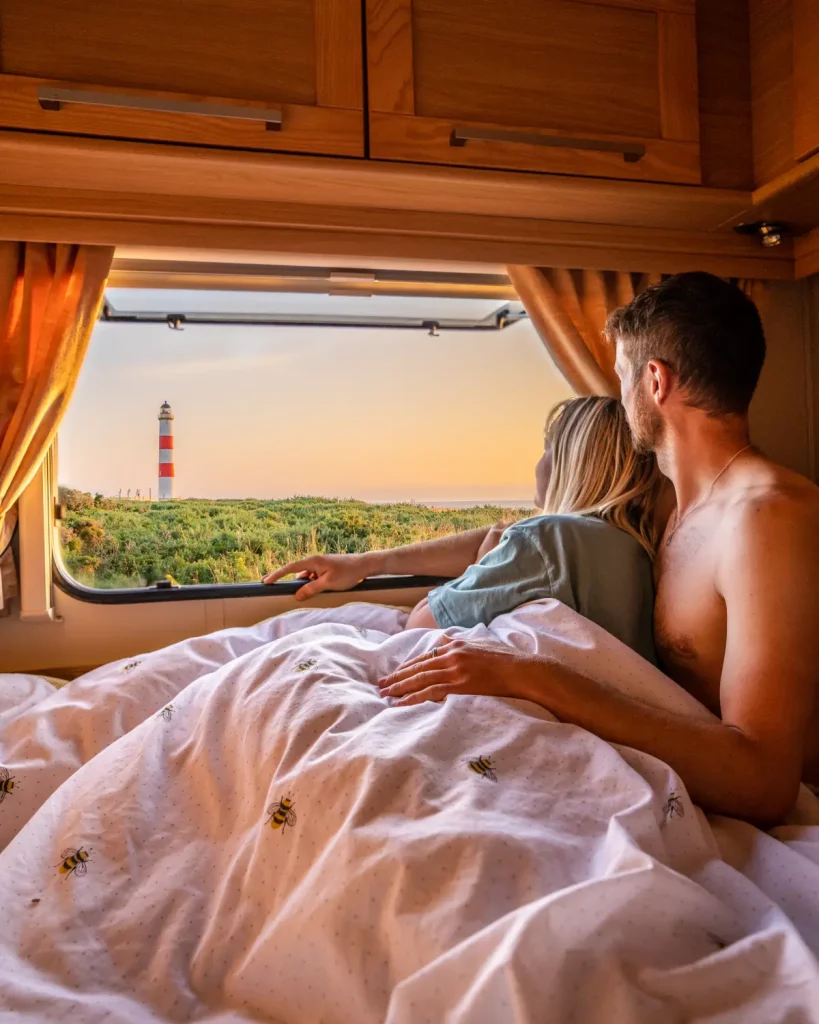
What Should I Pack?
When it comes to packing for a trip to Scotland there is one item of clothing that you are going to need all year round: a waterproof. It rains in Scotland on average 250 days a year, meaning that during your 5-day Heart 200 road trip you will probably experience at least a drizzle of rain. Due to this, the number one item on any Scotland packing list is a good waterproof jacket.
As for the rest of the year, the temperature in Scotland and the central heartlands is reasonably mild for most of the year. During the winter months, you will most likely experience snow, however, temperatures usually sit around freezing, so it is not too cold. For your reference, the average temperatures in Scotland are listed below during each season.
Spring (March, April, May) – 5-10 degrees C
Summer (June, July, August) – 15 degrees C
Autumn (September, October, November) – 5-10 degrees C
Winter (December, January, February) – 0-5 degrees C
As you can see, the weather never really gets above the teens, with anything over 25 degrees C considered a heatwave. The best way to pack for your trip to the highlands is with layers that can be added and removed as you need them. You will definitely need a hat and gloves during the colder months and will most likely need sunscreen to protect you on the long days in the open.
We would also recommend taking our NC500 guidebooks with you on your journey. This will help you plan your itinerary and ensure that you don’t miss out on any of the best places to go on the NC500. Our Destination NC500 guidebook is well paired with NC500 Where to Eat and Stay and you can buy the combo here.
Given the beautiful sights and scenery that you are no doubt going to see around Scotland, we highly recommend packing a good camera for your trip. If you want to read more about the cameras we use and why we love them, check out the link below.
Photography Equipment
Main Photography Camera – Sony A7v Mirrorless Camera and Sony A7iii Mirrorless Camera
Microphone – Sony Mic ECM-B1M
Main Lens – Tamron 17-28mm f/2.8
Zoom Lens – Tamron 70-180mm f/2.8
Camera Tripod – ZOMEI Z669C Camera Tripod
Gorilla Pod – JOBY JB01507-BWW GorillaPod
Action Camera – GoPro Hero 11 and Insta 360 One RS
Drone Camera – DJI Mavic Pro 3
Camera Bag – Wandrd PRVKE 41L and The Nest by Tropicfeel
Phone Tripod – Manfrotto MKPIXICLAMP-BK, Mini Tripod with Universal Smartphone Clamp
Sturdy Phone Tripod & Selfie Stick – ATUMTEK 61″ Selfie Stick Tripod, Sturdy Phone Tripod Stand with Wireless Remote
Hard Drives – LaCie Rugged Mini, 5TB, 2.5″, Portable External Hard Drive
SSD – SanDisk Extreme Pro 1TB Portable NVMe SSD
Travel Adapter –Worldwide Travel Adapter Universal Travel Plug with 4 USB Ports+Universal AC Socke
What is the Best Travel Insurance for the North Coast 500
I know travel insurance is the least enjoyable thing to purchase and look at when you’re planning a trip, however, you wouldn’t want to be without it in the event that something happened. Accidents can happen anywhere and the extortionate medical bills will ruin your trip if you are not covered.
To ensure you have a stress-free trip with no worries about potential medical bills, make sure you cover yourself when you travel. We can recommend using SafetyWing, a backpacker-friendly and cheap insurance company that provides good coverage and support. It is also nomad-friendly, unlike most other insurance companies, meaning you do not need to worry about being out of your home country for too long.
Get a quote for your travel insurance right here and get covered!
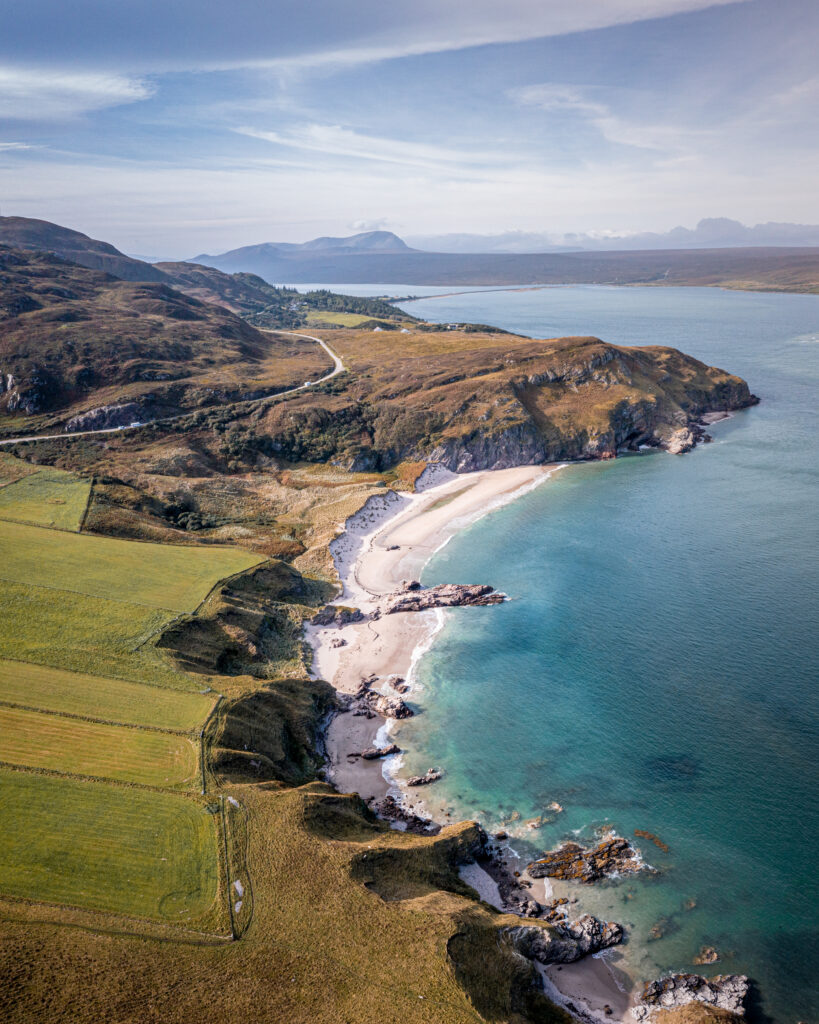
So there you have it, all of the best sights along the North Coast 500, including castles, cliff views, and stunning harbour towns. If you have visited the NC500 recently, let us know what you thought of the sights listed above, or if you have any suggestions let us know in the comments below.
As always, sharing is caring so make sure to share this guide with your family and friends and inspire them to head off on their own North Coast 500 adventure. If you are planning the trip for yourself, make sure you have a look at the rest of our Scotland content for more inspiration to our beautiful home country.
When you set off on your own adventure, be sure to tag us in your photos on Instagram and we will share them with the rest of our community. In the meantime, why not follow us over there to see what we are currently up to and keep up with us on our Instagram Stories.
Now Read:
This article may contain affiliate links that provide us with a small income. For more information read our Affiliate page.
Pin it for later!
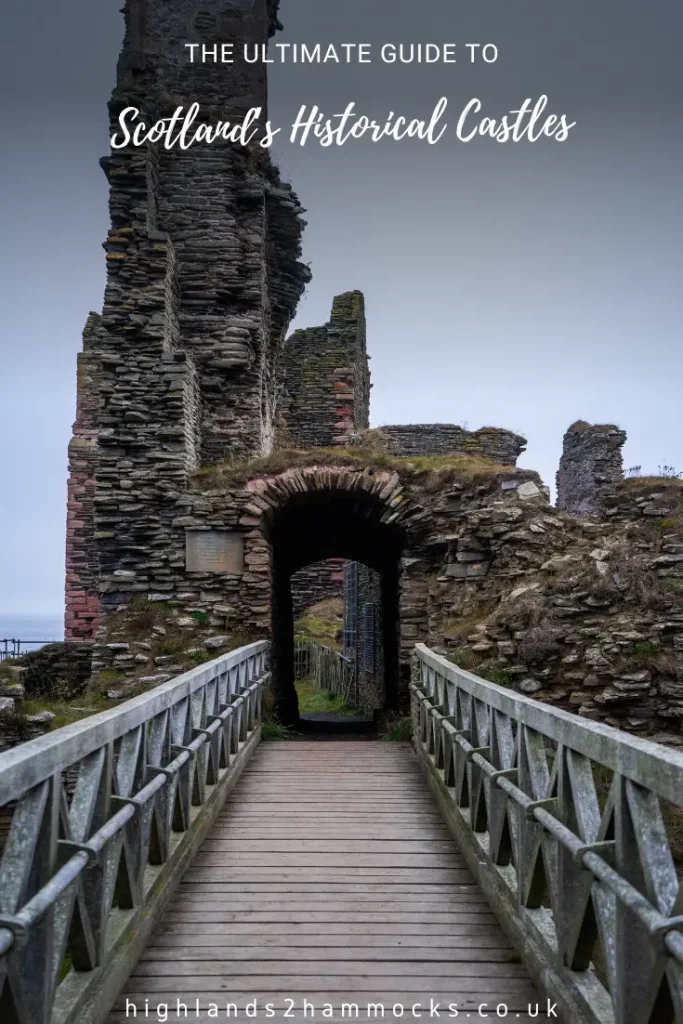
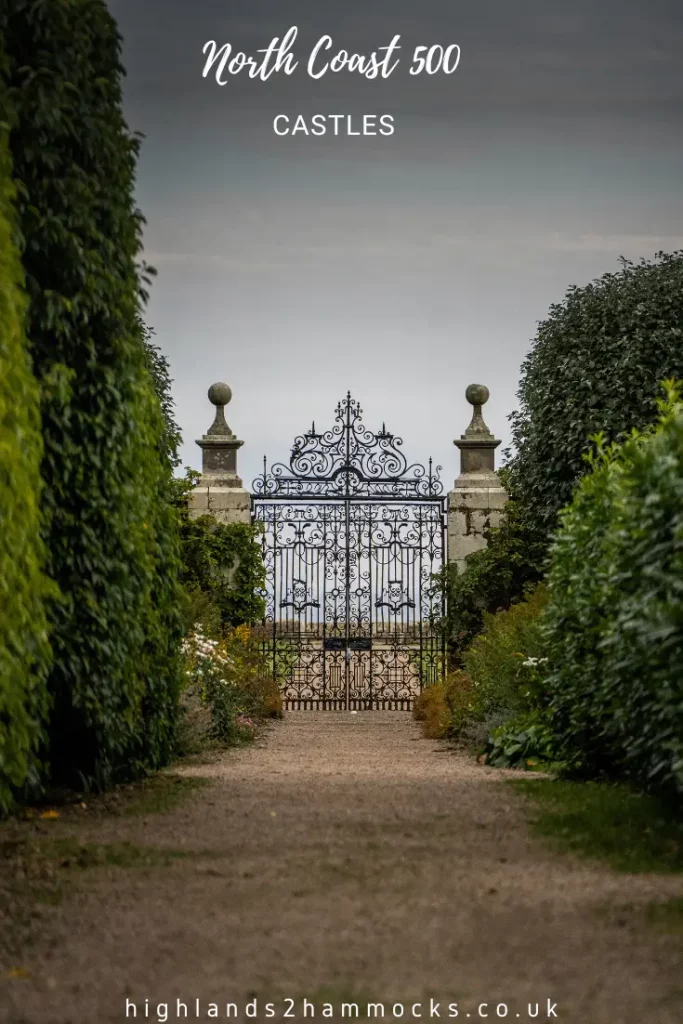
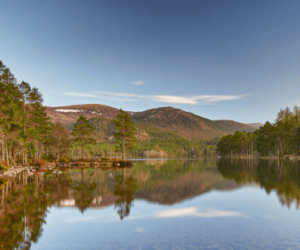
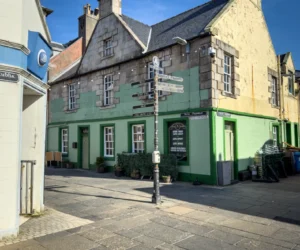

So very cool! I’ve dreamed of visiting Scotland my whole life yet never have, these castles are such a brilliant fantasy for me!
Can’t wait to get a chance to visit!
Aw man they are incredible! If you ever do go hit us up and we will join 😀
If there is one thing I love its a castle and although I knew Scotland had plenty to offer this selection has offered me far too much choice for the Scottish road trip I want to do next year! Still so much to explore!
Aww you will be spoiled for choice then! All over Britain and Ireland you will find some beautiful castles. Glad you enjoyed the post!
Pingback: Wild Camping Spots around the NC500 | highlands2hammocks
Pingback: North Coast 500 Campsites - Best Campsites along the Scotland 500 Route | highlands2hammocks
Pingback: North Coast 500 Highlights - 19 Best Sights Along the NC500 | highlands2hammocks
Pingback: Castle Sinclair Girnigoe Ruins, NC500 - WHAT, WHERE AND WHY.. | highlands2hammocks
Pingback: 7-day North Coast 500 Itinerary - FREE, Detailed and Unforgettable! | highlands2hammocks